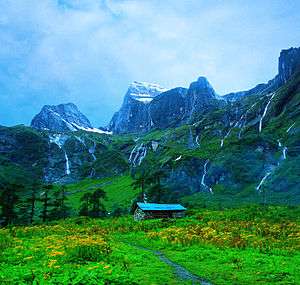Beyul
| Part of a series on |
| Tibetan Buddhism |
|---|
 |
|
Practices and attainment |
|
History and overview |
|
According to the beliefs of the Nyingma school of Tibetan Buddhism, Beyul (Tibetan: སྦས་ཡུལ, Wylie: sbas-yul ) are hidden valleys often encompassing hundreds of square kilometers, which Padmasambhava blessed as refuges. Tertöns may reveal them from terma at specific and appropriate times. Their locations were kept on scrolls (lamyig or neyig) hidden under rocks and inside caves, monasteries and stupas. They are places where physical and spiritual worlds overlap and Tantric practice effectiveness increases with multiple perception dimensions.[1]
Padmasambhava assigned deities to protect the beyul. Protective forces manifest as snowstorms, mists and snow leopards. Buddhist texts indicate beyul are discovered when the planet is approaching destruction and the world becomes too corrupt for spiritual practice. They describe valleys reminiscent of paradise, which can only be reached with enormous hardship. Pilgrims who travel to these wild and distant places often recount extraordinary experiences similar to those encountered by Buddhist spiritual practitioners on the path to Liberation. People who try to force their way in, may encounter failure and death. Beyul retreat time has concentrated benefits. The places originate from a faith which has traditional natural site respect. Life in beyul is sacred and protected.[2] [3] Earthly beyuls share significant characteristics with Shambhala, which is the greatest hidden valley.[4]
A recent attempt to open a beyul occurred in 1962, when the Tibetan lama Tulshuk Lingpa journeyed to Sikkim in order to 'open' Beyul Demoshong, a beyul fabled to exist on the slopes of Mount Kanchenjunga straddling the Nepal/Sikkim border. He took with him over 300 followers from across the Himalayas and Tibet, each of whom had given away his or her worldly goods. Their story is told in the recent book, A Step Away from Paradise.[5]

In Buddhism, sacred environments are places to deeply enter the world, and to avoid escaping it. The qualities inherent in such places reveal the interconnectedness of all life and deepen awareness of the spirit and mind's hidden regions. Visiting beyul with good motivation and appropriate merit, the pilgrim can learn to see the world differently from the way it commonly appears, developing and enhancing the Buddhist virtues of wisdom and compassion. Inside beyul, people should abandon their negative actions. The lands embody dharmapala and lords of the land, which are associated with the geographic features such as mountain, trees, rocks and water sources. In custom, ritual offerings are made to these spirits to appease their wrathful nature and with the symbolic unity that people share with them. The attitude affords a sustainable approach toward land stewardship. [6]
In Nepal and Tibet around Mount Everest are the Khenbalung, Solukhumbu, Rolwaling, Rongshar, Kyirong and Nubri sacred valleys.[7] The Sherpa people discovered Solukhumbu when they left Tibet to escape religious persecution in the 15th and 16th centuries. They entered the valley to seek refuge and made a new homeland there. Buddhist monasteries and sacred mountains have brought many spiritual travelers to Solukhumbu. Traditional beyul are found in the Himalayan regions of Nepal, Tibet, Sikkim, Bhutan, India, China and Pakistan.
See also
- Barun Valley
- Shangri-La
- Sagarmatha National Park
- Tagzig Olmo Lung Ring
- "Beyul: Sacred Hidden Valleys of the Himalaya by The Mountain Institute" on YouTube
References
- ↑ Baker, Ian (May 2, 2006). The Heart of the World: A Journey to Tibet's Lost Paradise (Reprint ed.). Penguin Books. p. 544. ISBN 978-0143036029.
- ↑ Norbu Sherpa, Lhakpa (2008). Through a Sherpa Window: Illustrated Guide to Sherpa Culture. Kathmandu, Nepal: Vajra Publications. ISBN 978-9937-506-20-5.
- ↑ Christopher McLeod (2009–2010). "Beyul of the Himalaya". Earth Island Institute. Retrieved 30 September 2010.
- ↑ Dmitrieva, Victoria (1997). "Be-yuls: Shambhala on Earth". The Legend of Shambhala in Eastern and Western Interpretations (MA thesis). Mc Gill University.
- ↑ Shor, Thomas (2011). A Step Away from Paradise. Penguin India, Amazon. ASIN B006TR0Y7W. ISBN 9780143415466.
- ↑ Mallarach, Josep-Maria; Spoon, Jeremy; Norbu Sherpa, Lhakpa (January 16, 2009). Protected landscapes and cultural and spiritual values. Earthprint. pp. 68–79. ISBN 978-3-925064-60-9.
- ↑ Reinhard, Johan (1978) Khembalung: The Hidden Valley. Kailash, A Journal of Himalayan Studies 6(1): 5-35, Kathmandu.